An ascocarp, or ascoma, is the fruiting body (sporocarp) of an ascomycete phylum fungus. It consists of very tightly interwoven hyphae and millions of embedded asci, each of which typically contains four to eight ascospores. Ascocarps are most commonly bowl-shaped (apothecia) but may take on a spherical or flask-like form that has a pore opening to release spores (perithecia) or no opening (cleistothecia).

The genus Aesculus, with species called buckeye and horse chestnut, comprises 13–19 species of flowering plants in the family Sapindaceae. They are trees and shrubs native to the temperate Northern Hemisphere, with six species native to North America and seven to 13 species native to Eurasia. Several hybrids occur. Aesculus exhibits a classical Arcto-Tertiary distribution.
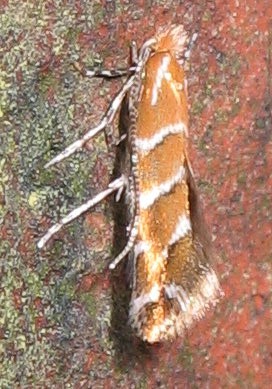
The horse-chestnut leaf miner is a leaf-mining moth of the family Gracillariidae. The horse-chestnut leaf miner was first observed in North Macedonia in 1984, and was described as a new species in 1986. Its larvae are leaf miners on the common horse-chestnut. The horse-chestnut leafminer was first collected and inadvertently pressed in herbarium sheets by the botanist Theodor von Heldreich in central Greece in 1879.

Bay is a hair coat color of horses, characterized by a reddish-brown or brown body color with a black point coloration on the mane, tail, ear edges, and lower legs. Bay is one of the most common coat colors in many horse breeds.
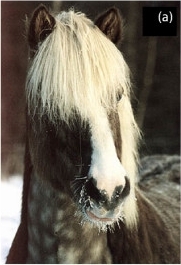
The silver or silver dapple (Z) gene is a dilution gene that affects the black base coat color and is associated with Multiple Congenital Ocular Abnormalities. It will typically dilute a black mane and tail to a silvery gray or flaxen color, and a black body to a chocolaty brown, sometimes with dapples. It is responsible for a group of coat colors in horses called "silver dapple" in the west, or "taffy" in Australia. The most common colors in this category are black silver and bay silver, referring to the respective underlying coat color.
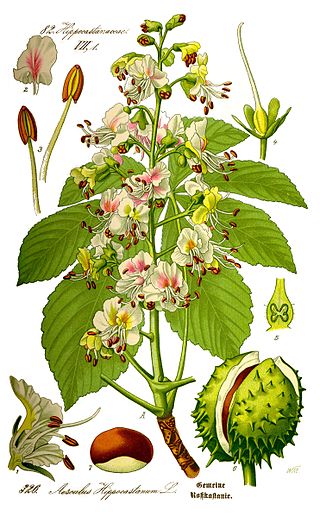
Aesculus hippocastanum, the horse chestnut, is a species of flowering plant in the maple, soapberry and lychee family Sapindaceae. It is a large, deciduous, synoecious (hermaphroditic-flowered) tree. It is also called horse-chestnut, European horsechestnut, buckeye, and conker tree. It is not to be confused with the Spanish chestnut, Castanea sativa, which is a tree in another family, Fagaceae.

Mauritia flexuosa, known as the moriche palm, ité palm, ita, buriti, muriti, miriti (Brazil), canangucho (Colombia), morete or acho (Ecuador), or aguaje (Peru), is a palm tree. It grows in and near swamps and other wet areas in tropical South America.

The chestnut, also known as a night eye, is a callosity on the body of a horse or other equine, found on the inner side of the leg above the knee on the foreleg and, if present, below the hock on the hind leg. It is believed to be a vestigial toe, and along with the ergot form the three toes of some other extinct Equidae. Darren Naish dissents from this belief, noting that the chestnut is "not associated with the metacarpus or metatarsus, the only places where digits occur."

Chestnut is a hair coat color of horses consisting of a reddish-to-brown coat with a mane and tail the same or lighter in color than the coat. Chestnut is characterized by the absolute absence of true black hairs. It is one of the most common horse coat colors, seen in almost every breed of horse.

Horses exhibit a diverse array of coat colors and distinctive markings. A specialized vocabulary has evolved to describe them.

Black is a hair coat color of horses in which the entire hair coat is black. Black is a relatively uncommon coat color, and it is not uncommon to mistake dark chestnuts or bays for black.
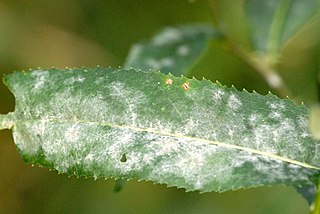
Erysiphe cichoracearum is a fungal plant pathogen that causes powdery mildew disease of cucurbits, including melon, cucumber, pumpkin, and squash. The primary symptoms are white, powder-like spots on the leaves and stems. Sphaerotheca fuliginea causes a similar looking powdery mildew of cucurbits.
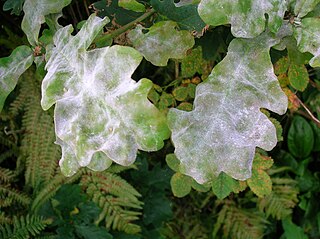
Erysiphe is a genus of fungi in the family Erysiphaceae. Many of the species in this genus are plant pathogens which cause powdery mildew.

Roan is a horse coat color pattern characterized by an even mixture of colored and white hairs on the body, while the head and "points"—lower legs, mane, and tail—are mostly solid-colored. Horses with roan coats have white hairs evenly intermingled throughout any other color. The head, legs, mane, and tail have fewer scattered white hairs or none at all. The roan pattern is dominantly inherited, and is found in many horse breeds. While the specific mutation responsible for roan has not been exactly identified, a DNA test can determine zygosity for roan in several breeds. True roan is always present at birth, though it may be hard to see until after the foal coat sheds out. The coat may lighten or darken from winter to summer, but unlike the gray coat color, which also begins with intermixed white and colored hairs, roans do not become progressively lighter in color as they age. The silvering effect of mixed white and colored hairs can create coats that look bluish or pinkish.
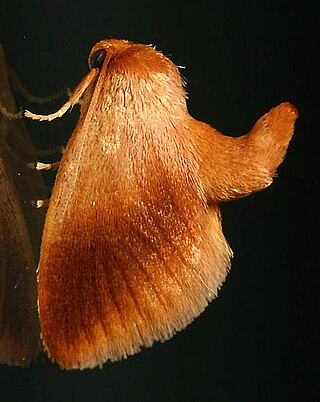
The warm-chevroned moth is a moth of the family Limacodidae. It is found from Nova Scotia west and south to Manitoba, Missouri and Mississippi. There is also a record from South Carolina.

Erysiphe alphitoides is a species of fungus which causes powdery mildew on oak trees.
Flexuosa, meaning "full of bends" in Latin, may refer to:
Erysiphe azerbaijanica is a species of powdery mildew in the family Erysiphaceae. It is found in Azerbaijan, where it grows on the leaves of sweet chestnut trees.













